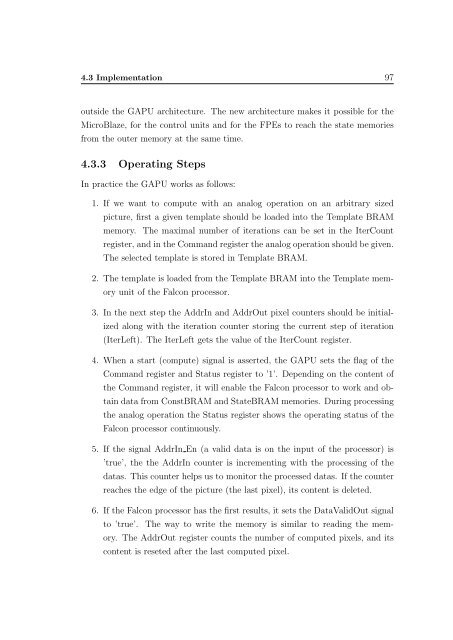PPKE ITK PhD and MPhil Thesis Classes
PPKE ITK PhD and MPhil Thesis Classes
PPKE ITK PhD and MPhil Thesis Classes
You also want an ePaper? Increase the reach of your titles
YUMPU automatically turns print PDFs into web optimized ePapers that Google loves.
4.3 Implementation 97<br />
outside the GAPU architecture. The new architecture makes it possible for the<br />
MicroBlaze, for the control units <strong>and</strong> for the FPEs to reach the state memories<br />
from the outer memory at the same time.<br />
4.3.3 Operating Steps<br />
In practice the GAPU works as follows:<br />
1. If we want to compute with an analog operation on an arbitrary sized<br />
picture, first a given template should be loaded into the Template BRAM<br />
memory. The maximal number of iterations can be set in the IterCount<br />
register, <strong>and</strong> in the Comm<strong>and</strong> register the analog operation should be given.<br />
The selected template is stored in Template BRAM.<br />
2. The template is loaded from the Template BRAM into the Template memory<br />
unit of the Falcon processor.<br />
3. In the next step the AddrIn <strong>and</strong> AddrOut pixel counters should be initialized<br />
along with the iteration counter storing the current step of iteration<br />
(IterLeft). The IterLeft gets the value of the IterCount register.<br />
4. When a start (compute) signal is asserted, the GAPU sets the flag of the<br />
Comm<strong>and</strong> register <strong>and</strong> Status register to ’1’. Depending on the content of<br />
the Comm<strong>and</strong> register, it will enable the Falcon processor to work <strong>and</strong> obtain<br />
data from ConstBRAM <strong>and</strong> StateBRAM memories. During processing<br />
the analog operation the Status register shows the operating status of the<br />
Falcon processor continuously.<br />
5. If the signal AddrIn En (a valid data is on the input of the processor) is<br />
’true’, the the AddrIn counter is incrementing with the processing of the<br />
datas. This counter helps us to monitor the processed datas. If the counter<br />
reaches the edge of the picture (the last pixel), its content is deleted.<br />
6. If the Falcon processor has the first results, it sets the DataValidOut signal<br />
to ’true’. The way to write the memory is similar to reading the memory.<br />
The AddrOut register counts the number of computed pixels, <strong>and</strong> its<br />
content is reseted after the last computed pixel.






![optika tervezés [Kompatibilitási mód] - Ez itt...](https://img.yumpu.com/45881475/1/190x146/optika-tervezacs-kompatibilitasi-mad-ez-itt.jpg?quality=85)









